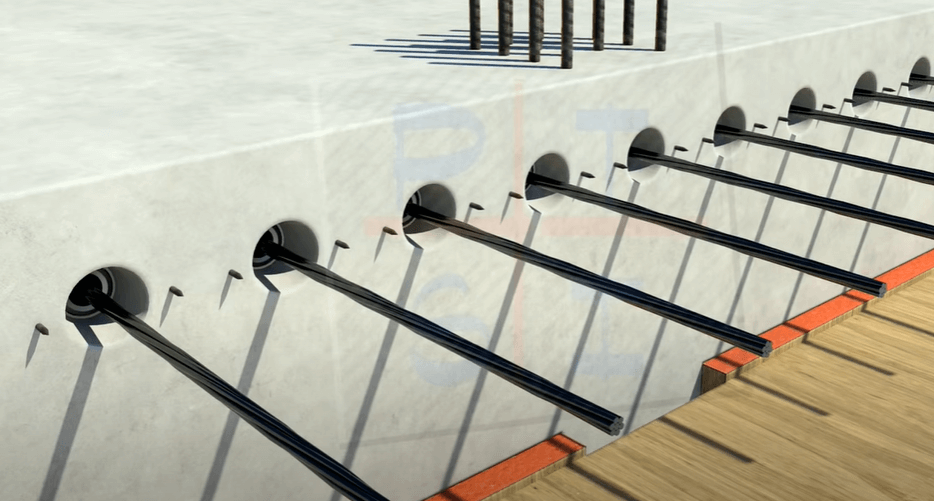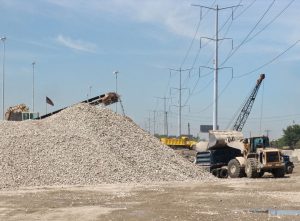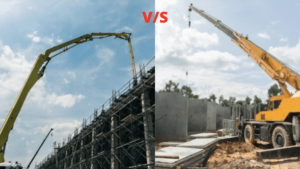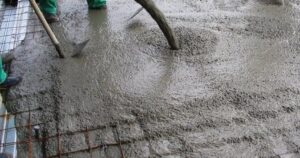Prestressed concrete is a structural material that allows pre-defined engineering pressure to be placed in members to counteract stresses prone to loading. It combines the high-pressure properties of concrete and the high tensile strength of steel.
Concrete can withstand a significant amount of compressive stress, but concrete has two weaknesses. One, it has no strength against tension, and number two, it is brittle. Because of these two weaknesses, concrete gets cracks when subjected to maximum load.
The need for Prestressed Concrete
When we design a concrete structure, we design it for ultimate strength, which means the structure should not collapse in the worst-case scenario. And another essential design criterion is that there should not be any movement or deflection when a load is applied to the structure. Before the concrete structure’s failure, cracks are formed in the concrete, and then the structure collapses.
Cracks are formed due to deflection or movement in the structure. When water comes in contact with these cracks, the steel gets corroded.
Pre-stressing is done to
- avoid cracks,
- increase the strength of members,
- reduce deflection.
What is pre-stressing?
Pre-stressing means tensioning the reinforcement; for example, take the case of a bridge over a river. If you try to construct this bridge with traditional concrete, we will increase the span depth. So, there will be no enough space under the bridge for ships to pass.
So, to have a lot longer span and more strength, this pre-stressing is done. When we apply load on the concrete member, the member bends downward, compression develops on the top portion, and tension develops at the bottom portion.
The bottom concrete gets cracks due to this elongation. We add some steel bars at the bottom section and stretch it to resist most of the tension and so the concrete from cracking, called Prestressing. In pre-stressing, the tendons are stretched along the axis, and concrete is poured.
Later, when the tendons are released, the compression is generated at the bottom, trying to counterbalance the compression due to loading at the top of the beam. The upward force along the length of the beam counteracts the service loads applied to the member.
Prestressing removes the design limitations of conventional concrete and permits the building of roofs, floors, bridges, and walls with longer unsupported spans.
Because of this ability, prestressed concrete is used in school auditoriums, shopping centers, gymnasiums, parking garages, and cafeterias. It is now commonly used for floor beams, piles, receivers, and structures such as water tanks and runways.
Methods of Pre-stressed Concrete
- Pre-tensioning
- Post-tensioning
Pre-tensioning
In the pre-tensioning method, before placing the concrete, the steel is stretched. High-strength steel tendons are placed between two ends and stretched up to 70 to 80% of the ultimate strength. Later the concrete is poured around the tendons and allowed to cure. Stretching forces are released when concrete gains required strength.
When highly stressed steel attempts to contract, the concrete gets compressed, then the concrete will be in a permanent state of maintaining pre-stressed strength. This method creates a good bond between the tendons and the concrete, which protects the tendons from corrosion and allows direct stress transfer.
The hardened concrete adheres to the bars and, when the stress is released, enters the concrete in the form of compression by static friction. However, this system requires strong anchor points between which the tendons must be stretched. The tendons are usually straight. Thus, most prestressed concrete elements are prefabricated at the factory and must be delivered to the construction site.
This process involves tensioning the wires or cables by attaching them to the end of a metal mold that can be up to 120 m long. Hydraulic jacks tension the wire as needed, often adding 10% to account for creep and any other pre-stress losses.
The side molds are then fixed, and the concrete is placed around the tensioned wires. The concrete hardens and shrinks, gripping the steel along its entire length and transmitting the jacks’ tension to exert a compressive force on the concrete.
Typical concrete strength of 28 N / mm2 can be achieved by 24 hours of steam curing and the use of additives.
Communally the pre-tensioning concrete members are fabricated in a factory and must be transported to the construction site. In place of tendons, while transporting cables, high tensile steel bars can also be used for mentioning.
Examples of pre-tensioning concrete precast products are foundation pile railway sleepers, electrical or lightning poles, floor slabs, beams, pipe, partition one, etc.
Post-tensioning
In post-tensioning, the steel is stretched after the concrete hardens, unlike pre-tensioning work. Post tension is usually carried out at the project site. In the case of post-tensioning, a sleeve or duck is placed into the concrete structure. Concrete is cast and allowed to cure.
When the concrete reaches its required strength, the tendons are stretched and locked with anchors. The excess ends of tendons are then cut away, and the duck will be grouted and covered with concrete for loss prevention.
Stress is suppressed after fixing the concrete with one or both ends of the member’s hydraulic jack. Due to the high spatial pressure at the anchor positions, it is common for the helical reinforcement to be incorporated into the design.
When the desired stress has been reached, The excess ends of tendons are then cut away, and the duck will be grouted and covered with concrete for loss prevention.
For example, post-tensioning our roads, bridges, railways, today’s dams, containment tanks, reservoirs, underground constructions, foundations, buildings, industrial facilities, air and seaports, and spatial structures form of prestressed concrete structures, etc.
Advantages of Prestressed Concrete
These are some advantages of Pre-stressed concrete.
- With the help of pre-stressed concrete, sleek and slender concrete structures can be constructed.
- Due to this dead load of the structure gets reduced.
- Consumption of materials like concrete and steel is reduced.
- Longer beams spans and girders can be constructed, which gives untroubled floor space and parking facilities.
- It has long-term durability. The possibility of steel corrosion and subsequent concrete deterioration is declined because concrete is crack-free.
- Prestressed concrete bridges are not easily damaged by fire. They have excellent fire resistance and low maintenance costs.
- In comparison to reinforced concrete, prestressed concrete offers greater load resistance and shock resistance.
- The compressive strength of concrete and tensile strength of steel is used to their fullest.
Disadvantages of prestressed concrete.
- Prestressed concrete requires high-quality, dense concrete of high strength, perfect quality concrete in production, placement, and compaction is required.
- It requires high tensile steel, which is 2.5 to 3.5 times costlier than Wall Street.
- The prestressing process requires complicated tensioning equipment and anchoring devices, which are very costly.
- Prestressed concrete construction requires perfect quality control and supervision.
- This stressed concrete needs skilled laborers.
- Prestressing is not economical for short spans and light loads.
The need for high strength concrete
The reason is, that if the concrete is not strong enough, it can be cracked or failed when tendons stress it. Moreover, high-strength concrete is less subjected to shrinkage cracks. It has a higher modulus of plasticity and smaller grip strength.
Read Also: Different Types of Concrete





